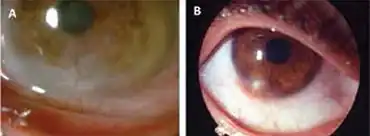Ocular rosacea
| Ocular rosacea | |
|---|---|
 | |
| Specialty | Ophthalmology |
| Symptoms | Redness, irritation or burning of the eyes, irregular eyelid margin, other signs of rosacea[1][2] |
| Complications | Corneal ulcer[3] |
| Usual onset | Adult[1] |
| Duration | Long term[1] |
| Causes | Unclear, Demodex[4] |
| Risk factors | Rosacea affecting skin[1] |
| Diagnostic method | Signs and symptoms[1] |
| Prevention | Avoid triggering factors: caffeine, spicy foods, alcohol, UV light.[4] |
| Treatment | Eyelid hygiene, antibiotics[4] |
| Medication | Doxycycline 40mg-50mg daily by mouth,[5] Ciclosporin eye drops[4] |
| Prognosis | Recurrence[1] |
| Frequency | Common,[5] males=females[6] |
Ocular rosacea is a type of rosacea that affects the eyes.[1][2] It generally presents with features of eyelid inflammation, recurrent cysts in the eyelid and conjunctivitis.[6] The inflammation may be in the eye itself; keratitis, iritis, episcleritis.[6] The eye may appear red, with a feeling of irritation, burning, itchiness or watering.[1][5] Typically, both eyes are affected, although symptoms may be present in just one.[4] Eyelid margins might appear irregular and both lids and conjunctiva may have tiny visible blood vessels.[1] Other symptoms include sensitivity to light, having a feeling that something is in the eye, and blurry vision.[1][5] Crusts may be seen at the base of eyelashes.[1] Sometimes there are no symptoms.[6] Diagnosis is more obvious if signs of other types of rosacea are also present, such as easy facial flushing, red cheeks, or small bumps on the nose.[1] Some signs might be difficult to see on dark skin.[1] Complications include corneal ulcer.[3] Loss of vision is rare.[1]
Counts of the Demodex mite have been found to be higher on the eyelashes of individuals with ocular rosacea.[4] The condition has been associated with H. pylori.[4] There is no test to confirm ocular rosacea.[1] Diagnosis is by its signs and symptoms.[1] It can exist without other skin signs of rosacea.[1] Symptoms are typically long term with flare-ups and periods of recovery.[1] There is no correlation between the severity of rosacea affecting the eyes and severity of skin signs.[1] [5]
Treatment is generally with good eyelid hygiene; warm compresses, artificial tears and washing the area around the eye with warm water, including the eyelids.[4] Antibiotics by mouth, typically doxycycline, may be prescribed at a dose of 40mg-50mg daily by mouth.[5] Erythromycin is an alternative, particularly in pregnancy.[5] Ciclosporin eye drops may help reduce inflammation in more severe disease.[4] Avoiding triggering factors might involve excluding caffeine, spicy foods, and alcohol, along with using sun protection.[4]
The condition is common.[5] Males and females are affected equally.[6] Over half of people with rosacea affecting skin generally develop the condition in their eyes and around one fifth typically develop the disease in their eyes prior to experiencing signs in skin.[5] The condition can have a negative impact on the individual's quality of life.[4][5]
Signs and symptoms
 Clinical features/complications- Anterior segment photographs showing corneal neovascularization (A) and peripheral corneal infiltrate (B)
Clinical features/complications- Anterior segment photographs showing corneal neovascularization (A) and peripheral corneal infiltrate (B).jpg.webp) Ocular rosacea
Ocular rosacea
References
- 1 2 3 4 5 6 7 8 9 10 11 12 13 14 15 16 17 18 19 Wilkin, Jonathon; McGee, Jean S. (2023). "1. Introduction to clinical rosacea". In Cary, John Havens; Maibach, Howard I. (eds.). Rosacea. Switzerland: Springer. pp. 1–15. ISBN 978-3-030-52097-7. Archived from the original on 2023-07-22. Retrieved 2023-07-22.
- 1 2 "ICD-11 for Mortality and Morbidity Statistics". icd.who.int. Archived from the original on 1 August 2018. Retrieved 22 July 2023.
- 1 2 Dudee, Jitander (10 March 2023). "Ocular Rosacea: Background, Pathophysiology, Epidemiology". medicine.medscape.com. Medscape. Archived from the original on 22 July 2023. Retrieved 22 July 2023.
- 1 2 3 4 5 6 7 8 9 10 11 Fortenbach, Christopher R.; Tayh, Omar Jamal; Maibach, Howard; Modjtehadi, Babeck (2023). "6. Treatment of ocular rosacea". In Cary, John Havens; Maibach, Howard I. (eds.). Rosacea. Switzerland: Springer. pp. 67–76. ISBN 978-3-030-52097-7. Archived from the original on 2023-07-27. Retrieved 2023-07-25.
- 1 2 3 4 5 6 7 8 9 10 Rivero, Alex Lara; Whitfeld, Margot (1 February 2018). "An update on the treatment of rosacea". Australian Prescriber. 41 (1): 20–24. doi:10.18773/austprescr.2018.004. PMID 29507456. Archived from the original on 18 April 2023. Retrieved 22 July 2023.
- 1 2 3 4 5 James, William D.; Elston, Dirk; Treat, James R.; Rosenbach, Misha A.; Neuhaus, Isaac (2020). "13. Acne". Andrews' Diseases of the Skin: Clinical Dermatology (13th ed.). Elsevier. pp. 246–247. ISBN 978-0-323-54753-6. Archived from the original on 2023-07-27. Retrieved 2023-07-25.